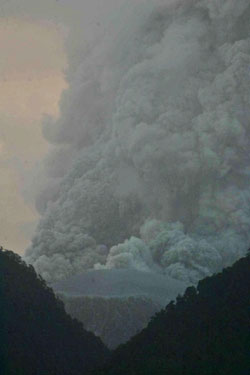Chile volcano blasts ash 20 miles high, forcing evacuations
(Agencies)
Updated: 2008-05-07 11:21
Updated: 2008-05-07 11:21
 Smoke rises from the Chaiten volcano, located some 1,225 km (761 miles) south of Santiago May 6, 2008. [Agencies] |
The fallout covered a third of Argentina's Minnesota-sized province of Chubut, provincial Gov. Mario Das Neves said.
While volcanologists around the world eagerly awaited data on the scope of the eruption, one local expert got an up-close look when he accompanied police and air force teams over the 3,950-foot (1,200 meter) peak.
Volcanologist Juan Cayupi told The Associated Press by telephone that Chaiten's two small craters have morphed into a large, single crater.
Lava was rising within the crater but has not yet spilled over, said Luis Lara, another volcanologist with the government's Geology and Mining Service.
Chilean President Michelle Bachelet, who visited the area Monday, has pledged financial help for people who lose homes or livestock. Farmers left behind about 40,000 head of livestock, and officials expressed fear that many of them could die.
But the possibility of the Chaiten volcano affecting Earth's climate is probably fairly low, experts said.
So far, Chaiten has emitted only a few thousand tons of sulfur dioxide, "which is very small," said Simon Carn, a University of Maryland-Baltimore volcanologist who uses satellites to measure volcanic gases.
In general, a volcano must spew at least 1 million tons of sulfur dioxide into the stratosphere to have a global effect on climate, said Alan Robock, a Rutgers University professor who co-authored a book on the subject.
After eruptions of unusual size, sulfur dioxide, converted into sulfuric acid, can form a thin white cloud in the atmosphere that reflects sunlight away from Earth.
The Philippines' Mount Pinatubo produced a brief cooling of the climate after spewing 20 million tons of sulfur dioxide in 1991.
But Robock said this volcano is so close to the South Pole that any cooling would likely be limited to the Southern Hemisphere.
|
||
|
||
|
|
|
|

